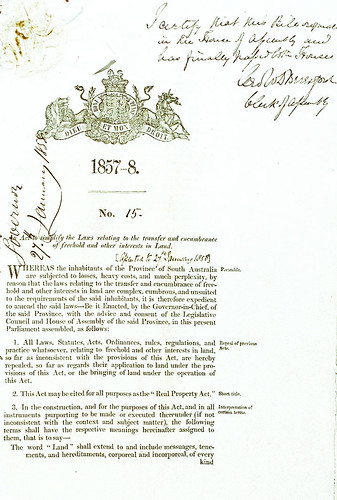 PARLIAMENT OF VICTORIA
PARLIAMENT OF VICTORIA PARLIAMENTARY DEBATES
(HANSARD)
LEGISLATIVE COUNCIL
FIFTY-SIXTH PARLIAMENT
FIRST SESSION
Tuesday, 26 February 2008
Land Victoria: electronic conveyancing
Mr D. DAVIS (Southern Metropolitan) — My question is to the Minister for Environment and Climate Change. My question relates to the state government’s continuing failure to secure major stakeholder support for its bungled electronic conveyancing system, which is forcing consumers to rely on paper-based conveyancing. Given that all paper-based conveyancing transactions now cost families an additional slug — in some cases, up to 30 per cent more for conveyancing — is it not true that the government stands to make windfall gains of the order of $6 million a year despite having botched the introduction of electronic conveyancing?
Mr JENNINGS (Minister for Environment and Climate Change) — The premise of the Leader of the Opposition’s question has a number of false aspects to it. The introduction of electronic conveyancing is a project I inherited. It was a long way down the development and implementation stage by the time I arrived as minister.
Mr D. Davis — You are walking away from it now.
Mr JENNINGS — Not at all. In fact I have been very active in that space. In the last few months I have spent a lot of time and effort talking to jurisdictions across this nation to galvanise the cross-jurisdictional delivery of this program. All Victorians and all Australians will benefit from an electronic system that streamlines conveyancing regimes and can be used by the financial institutions to enable the appropriate transaction of important information that, up until now, has been bedevilled by virtually Dickensian-type administrative practices.
Mr D. Davis — But reliable.
Mr JENNINGS — If Mr Davis had been talking to people in the sector, he would be aware that financial institutions want to move to electronic conveyancing. In fact all jurisdictions recognise the value of moving to an electronic conveyancing system. They want to make sure the platform is available for the widest variety of transactional programming within those financial institutions and that this can be shared across jurisdictions. The Victorian government has invested significantly in the development of this software and system — and in fact we are the only jurisdiction in the nation that has done so.
Mr D. Davis interjected.
Mr JENNINGS — Indeed, millions, Mr Davis. It is our unswerving commitment to deliver a national system that has seen a buy-in by financial institutions and other jurisdictions. One by one, the other states have shown an increasing preparedness to engage. We are very close to receiving endorsements of the application of this system in a number of jurisdictions. A number of jurisdictions across the nation have been using our software in trialling their accounting practices, and their land transfer and conveyancing procedures across the nation. I am confident that once a critical mass of state jurisdictions has been brought into this process and financial institutions are available to trial the software and the various applications — despite some teething problems in terms of getting a national buy-in to the rollout of this important program — at the end of the day the Victorian people will be well pleased that we will be at the heart of a national electronic conveyancing system which will have maximum compliance with other jurisdictions and financial institutions. In terms of the ongoing financial arrangements that underpin the establishment of this platform, the state of Victoria has been prepared and has been very willing to share its platform, which was developed at great expense to the people of Victoria with minimal return to the state, because we believe there will be national benefits from the rollout of the program.
Supplementary question
Mr D. DAVIS (Southern Metropolitan) — I note that the minister in no way disputes my figure of a $6 million windfall or that there are additional costs for paper-based conveyancing. Will the minister outline to the house when he expects the government’s electronic conveyancing system will win the support of major banks and the Law Institute of Victoria, and will he now commit to removing last November’s cost increase for paper-based conveyancing until such time as there is movement on this endorsement?
Mr JENNINGS (Minister for Environment and Climate Change) — Specifically the answer to the last part of the question is no, because there needs to be some incentive within the regime that will enable the take-up of this process to be seen not only to be electronically and administratively efficient but also, ultimately, to lead to savings. The cost structures that underpin the scheme were not designed by accident; they were designed on purpose to try to drive initial compliance and buy-in across the sector, with the regime embedded in ultimately cheaper cost structures and a greater applicability of the electronic conveyancing system.
PARLIAMENT OF VICTORIA
PARLIAMENTARY DEBATES
(HANSARD)
LEGISLATIVE COUNCIL
FIFTY-SIXTH PARLIAMENT
FIRST SESSION
Thursday, 28 February 2008
Land Victoria: electronic conveyancing
Mr D. DAVIS (Southern Metropolitan) — My matter today concerns the government’s electronic conveyancing system, which shows all the signs of being a  .
.
In no way do I oppose the move to electronic conveyancing, it is just that the government’s implementation of this system is proving to be a blunder — the system looks like it is a bit of a dog  .
.
The idea is to slug families when they purchase properties. Around 400 000 conveyancing transactions occur each year in Victoria, and the government is just creaming off additional money, because it has raised the fees for conveyancing done using paper forms. The unfortunate consumers of these services are now forced to return to paper conveyancing because of a lack of quality, reliability and certainty with the electronic conveyancing system. The Law Institute of Victoria has made its position clear, as has the Master Builders Association of Victoria. The association wrote a letter, dated 3 September, which says:
However, the building industry and consumers should not be punished for choosing one application process over another.
The Law Institute of Victoria has made it clear that it has great concerns about the new system. Until these issues, that also concern the banks are sorted out, the Minister for Innovation should not be imposing punitive fees on families.
PARLIAMENT OF VICTORIA
PARLIAMENTARY DEBATES
(HANSARD)
LEGISLATIVE COUNCIL
FIFTY-SIXTH PARLIAMENT
FIRST SESSION
Thursday, 13 March 2008
Hansard p773
Questions on Notice
Land Victoria: electronic conveyancing Mr D. DAVIS (Southern Metropolitan) — My adjournment matter is for attention of the minister in the chamber, the Minister for Environment and Climate Change. It relates to an area of his responsibility namely, the electronic conveyancing program — about which I have previously asked him questions in this chamber. He knows it is an issue I am deeply interested in. Obviously electronic conveyancing offers great prospects for cheaper conveyancing, better information, better services for consumers and better services for the industry. The minister and I agree completely on the prospect of what can be achieved in the future. Some concerns are, however, developing about the way Victoria is going about it. Victoria has taken a stand-alone approach and has got itself into problems. The system has been botched. As we know from questions in the chamber, fees have been put on paper conveyancing transactions that outweigh the fees payable on electronic transactions.
The PRESIDENT — Order! And the action?
Mr D. DAVIS — I am giving some background in terms of the fees, but I always appreciate your guidance and encouragement, President. Concurrent with the activities in Victoria, a national system has been considered. This is the essence of my point. I know, for example, that former New South Wales Premier Bob Carr has played a very unusual role in brokering certain aspects at the national level. I know also that the Australian Bankers Association is very concerned about the approach Victoria has taken. Indeed I am told the association is furious that the minister has gone away from it and not consulted in a proper and sufficient way to ensure that the needs of the banking industry are taken into full account as the new electronic conveyancing system is developed. It is for this reason that I ask the minister to fully consult with the Australian Bankers Association as electronic conveyancing goes forward and to ensure that electronic conveyancing is developed on the basis of a cooperative model rather than being done in a sneaky and underhanded way, which is what many are accusing the Victorian government of doing, because it has gone outside the national system. I ask the minister to take electronic conveyancing forward and to do that within a national framework in an open and collaborative way, rather than behind closed doors. In particular I ask him to consult closely with the Australian Bankers Association.
The PRESIDENT — Order! Prior to calling the minister, I inform Mr Thornley that unfortunately I am ruling his matter out of order, given that time had run out before he had actually asked for an action
Mr Thornley — On a point of order, President, I did try to put the action up the top and then go into detail. I was reiterating the action when I ran out of time.
The PRESIDENT — Order! Is Mr Thornley telling me that he had asked for an action at the start?
Mr Thornley — Yes.
The PRESIDENT — Order! I will accept his word for that.
Responses Mr JENNINGS (Minister for Environment and Climate Change) —
In his question David Davis tried to provoke me in my response. I can assure him that at no stage have I turned my back  on or ignored the views of the Australian Banking Association in relation to the rollout of the electronic conveyancing program. During the course of my responsibility for this program I can assure him, and I can assure the house, that there has never been a higher degree of collaboration and desire to give real life to a national scheme, and in fact that is my intention. While I could have disposed of the issue tonight, I am sure that over time Mr Davis will be interested in knowing how we proceed with this matter.
on or ignored the views of the Australian Banking Association in relation to the rollout of the electronic conveyancing program. During the course of my responsibility for this program I can assure him, and I can assure the house, that there has never been a higher degree of collaboration and desire to give real life to a national scheme, and in fact that is my intention. While I could have disposed of the issue tonight, I am sure that over time Mr Davis will be interested in knowing how we proceed with this matter.
David Davis MP - his profile





